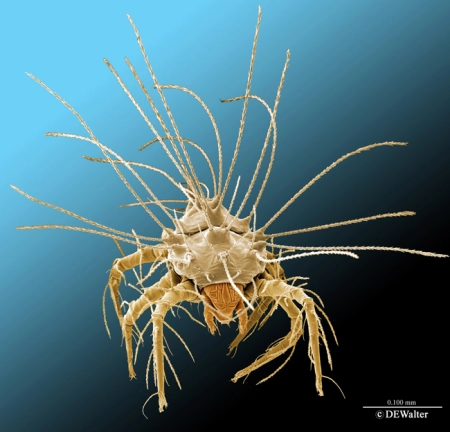
What is my secret name and what do I want from life?
‘To-morrow, and to-morrow, and to-morrow, Creeps in this petty pace from day to day’, but at last the the tomorrow promised in the last post (in March no less) has finally arrived. I plead overwork – I’ve had two massive taxonomic projects to complete including a listing of all of the species of mites known from Alberta – before the new field season commences. Above is one of these little monsters saying high and below are a number of them clinging to an insect collected from a rotting oyster mushroom (Pleurotus ostreatus). Any guesses to the mite, insect, spores, ecological interactions?

Mites & insect - name them both and what is happening.
ANSWER TO PHOTON CHALLENGE
I’m fairly pleased in how well everyone did in the first Photon Challenge, especially considering the quality of the pictures. Ray even got the fly to genus and Kaitlin got pretty close to the family of the mesostigmatan – at least according to the Manual of Acarology 3rd Edition the Halolaelapidae belongs in the Rhodacaroidea and they certainly are phoretic as deutonymphs, as one would expect in that superfamily. So Kaitlin gets points for that. Bruce got the family, and, I believe, the genus correct, at least in the broad sense: Halolaelaps s.l. Bruce has the advantage of having described the only known Australia species of the group and to have pointed out how messy the generic concepts are (see Halliday 2008 Systematic & Applied Acarology 13, 214–230). I am neutral on what superfamily Halolaelapidae belongs to – Rhodacaroidea is unlikely to be monophyletic and deutonymphal phoresy is probably a ‘primitive’ behaviour in Mesostigmata.

Deutonymph of Myianoetus - note bifurcate claws
Alas, no one guessed the genus of the histiostomatid – Myianoetus! All acarologists should know this genus if only because it contains one of the few mites to lurk among the pages (as an anoetid) of a large circulation, general science magazine – Science itself – and the interesting concept of ‘fly factors’:
Greenberg & Carpenter (1960) Factors in Phoretic Association of a Mite and Fly. Science 132: 738-739.
“Abstract: Combined rearing of the mite Myianoetus muscarum (L.), and the fly Muscina stabulans (Fall.) has revealed adaptations of the hypopus to a series of fly factors. These adaptations favor the mite’s dispersal. Hypopi are attracted to the pupa by a volatile substance and cluster on the anterior end, from which the fly emerges.”
Read the whole thing, as they say, but, although published over 50 years ago, you will still need access to Science to do so (and to read the next paper entitled ‘Licking Rates of Albino Rats’). Rat licking trailer aside, I think the most interesting thing about the Myianoetus paper is that I can’t remember any follow-ups that explain ‘fly factor’ or ‘beetle factor’ or ‘ant factor’. Most of the chemical clues used to induce or terminate phoretic behaviour in mites remain unknown. Only skatoles and dung beetles come to mind. If someone out there in the ether knows of other studies, please let me know – I can use the information to help a student.







